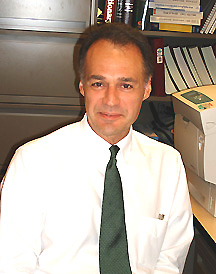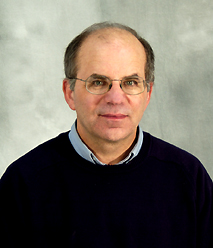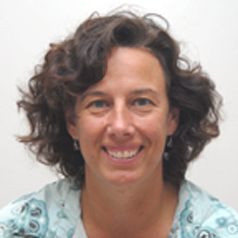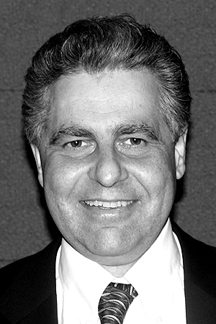
| T H E N I H C A T A L Y S T | S E P T E M B E R – O C T O B E R 2007 |
|
|
|
| P E O P L E |
RECENTLY TENURED
 |
|
Michael
Bishop
|
Michael R. Bishop received his M.D. degree from the University of Illinois College of Medicine–Chicago in 1985. He completed an internal medicine residency at Northwestern Memorial Hospital (Chicago) and a fellowship in hematology and oncology at the Loyola University Medical Center in Maywood, Ill. He was an associate professor and director of the Leukemia and Allogeneic Stem Cell Transplantation Programs at the University of Nebraska Medical Center, Omaha, before joining the NCI Experimental Transplantation and Immunology Branch in 1999 as clinical head of the Stem Cell Transplantation Program. He is currently a senior investigator and head of the Transplant Clinical Research Section in that branch.
My translational research has focused on allogeneic hematopoietic stem-cell transplantation. It has been our goal to increase the understanding of the biology related to the engraftment of allogeneic hematopoietic stem cells.
Based on murine data, we developed a novel treatment approach, which we refer to as targeted immune depletion, that permits individualized host conditioning according to immune status before transplantation. We were able to demonstrate that targeted immune depletion of host T cells permits the rapid and complete engraftment of allogeneic stem cells. We also demonstrated that circulatory T-cell numbers are a surrogate determinant of graft rejection risk.
As an extension of this work, we recently conducted a prospective clinical trial to determine the effects of targeted immune depletion on IL-7 and IL-15 in the allogeneic transplant setting. As we’d anticipated, we found that IL-7 and IL-15 levels rose from baseline in response to lymphopenia induced by targeted immune depletion and then decreased with lymphocyte recovery post-transplant.
We are now testing the targeted immune depletion approach with HLA-matched unrelated donors in a trans-institutional effort, supported by the National Marrow Donor Program, to extend transplant availability to more patients.
My second area of research has focused on optimizing the graft-versus-tumor (GVT) effect. Based on murine models, we hypothesized that allogeneic cellular therapy would result in a clinically significant GVT effect against metastatic breast cancer.
Our first clinical study was designed to separate the cytotoxic effects of the conditioning regimen from a potential GVT effect by T-cell depleting the allograft and then infusing allogeneic lymphocytes at a later time. This was the first trial to demonstrate a distinct GVT effect against metastatic breast cancer. We are now using Th2/Tc2 cells in our continuing research to enhance the GVT effect against breast cancer.
We are also studying ways to enhance the GVT effect against B-cell malignancies. Relapse is a major cause of treatment failure for patients with non-Hodgkin’s lymphomas (NHL) undergoing allogeneic hematopoietic stem-cell transplantation. The standard treatment for relapse after transplant is the infusion of additional allogeneic lymphocytes, referred to as a donor lymphocyte infusion (DLI). However, DLI has limited efficacy against most NHL.
Over the past two years, we have engaged in preclinical research to develop tumor-derived lymphocytes to treat recurrent disease after allogeneic hematopoietic stem-cell transplantation. We focused on methods of tumor preparation, based on a platform costimulation with CD3/CD28 beads and expansion with IL-2.
These studies have led to an FDA-approved pilot trial of allogeneic tumor-derived lymphocytes for the treatment of relapsed B-cell malignancies after allogeneic stem-cell transplant.
Our other effort in the enhancement of GVT effects in B-cell malignancies involves the use of idiotype (Id) vaccines in the treatment of multiple myeloma.
In collaboration with the laboratories of Larry Kwak and Sattva Neelapu at the M.D. Anderson Cancer Center in Houston, Texas, we have been conducting a pilot trial on sibling donor vaccination with Id-KLH, derived from the recipient before their allogeneic stem-cell transplant.
The results of this recently completed pilot trial demonstrated that donors could be safely vaccinated and that the large majority of donors had T-cell and/or B-cell responses to Id. Currently we are planning to expand the patient cohort from the pilot trial, and we are also planning to use Id vaccinations as part of transplant protocols for follicular lymphomas.
 |
| Joe
Hinnebusch |
B. Joseph Hinnebusch received his Ph.D. in microbiology from the University of Texas Health Science Center, San Antonio, in 1991 and did postdoctoral training with Tom Schwan at NIAID’s Rocky Mountain Laboratories (RML) in Hamilton, Mont. In 2001, he joined the Laboratory of Human Bacterial Pathogenesis at RML as a tenure-track investigator. He is now a senior investigator and head of the Plague Section in the Laboratory of Zoonotic Pathogens at RML.
Yersinia pestis, the gram-negative bacterial agent of bubonic and pneumonic plague, is one of the most invasive and virulent bacterial pathogens, and human plague remains an international public health concern. Y. pestis also has recognized potential as an agent of bioterrorism. There is currently no vaccine available for plague, and immune correlates of protection against plague are incompletely characterized. New diagnostic tests are also needed.
We study the molecular mechanisms of plague transmission, infection, and immunity.
Y. pestis is a zoonotic pathogen that primarily infects wild rodents and is transmitted by fleas. Using the rat flea Xenopsylla cheopis (the primary vector of plague to humans in most parts of the world), we have identified several Y. pestis genes that are required to produce a transmissible infection in the flea, and we have characterized the bacterial "transmission phenotype."
We have also established mouse and rat models to characterize the bacterial and host response during the progression of bubonic plague. Microarray analyses of Y. pestis and rat gene expression in the infected lymph node (bubo) as well as immunologic analyses support a model in which the fulminant nature of plague depends on the expression of several Y. pestis virulence factors that thwart the mammalian innate immune response. We are interested in understanding the in vivo function of these virulence factors and determining their specific targets and mechanisms of action.
Another goal is to expand and use these model systems to identify and evaluate new Y. pestis antigens for use in plague vaccines and diagnostics and to characterize the host response to naturally acquired infection. In collaboration with extramural researchers, we have already used our small-animal models to assess the efficacy of second-generation plague vaccines and delivery systems.
As one of the only laboratories in the world capable of studying plague transmission by fleas, we are also developing models to examine the vector-bacteria-host transmission interface and specific factors in the dermal fleabite site, such as flea saliva, that affect nascent infection and immunity.
 |
|
Olivia
Steele-Mortimer
|
Olivia Steele-Mortimer received her Ph.D. in cell biology from the University of London in 1994 for work carried out at the European Molecular Biology Laboratory (EMBL) in Heidelberg, Germany. She did her postdoctoral training with B. Brett Finlay at the University of British Columbia in Vancouver, Canada, and with Philip Stahl at Washington University, St. Louis. She became a tenure-track investigator at the Rocky Mountain Laboratories, NIAID, in 2001. She is currently a senior investigator, leading the Salmonella-Host Cells Interactions Section in the Laboratory of Intracellular Parasites.
The research in my laboratory focuses on the interaction of Salmonella with mammalian host cells. The genus Salmonella consists of more than 2,000 serovars that differ widely in host range and ability to cause disease despite the fact that they are almost identical genetically. The serovar that we work with is Typhimurium, one of the most common causes of bacterial gastroenteritis in the developed world.
My interest in host pathogen interactions began during my undergraduate days at the University of London, where I studied microbiology. However, it was at the EMBL cell biology department that I really started to appreciate the level of complexity involved in pathogen–host cell interactions. At that time cellular microbiology was just emerging as a new field and there was an apparent smorgasbord of pathogens about which very little was known.
I chose to work on Salmonella because this facultative intracellular pathogen can be genetically manipulated. My initial project proposal was to characterize the Salmonella-containing vacuole (SCV), a modified phagosome within which the intracellular bacteria survives and replicates. This has proven to be more of a challenge than we expected, but I was very lucky to start working on it just as light microscopy moved into the age of digital and live-cell imaging. We are now using a spinning-disc confocal microscope to define SCV dynamics and biogenesis in living cells. One of our major findings is that SCV biogenesis involves continuous dynamic interactions with the endocytic pathway and includes direct fusion with terminal lysosomes.
Like many other Gram-negative pathogens, Salmonella serovars inject bacterial effector proteins directly into host cells using specialized type III secretion systems (T3SS). We are interested in identifying these effector proteins and their targets in the host cell. One of the effectors we study, SopB/SigD, is an inositol phosphatase that causes activation of the pro-survival kinase Akt/PKB in Salmonella-infected epithelial cells. How this signal occurs is still not understood, but it seems to be an important anti-apoptotic signal that may be required in the establishment of infection in the intestinal epithelium.
Most recently we have also started investigating the expression of Salmonella virulence genes using a combination of microarrays, for transcriptome analysis, and GFP transcriptional fusion, for the detection of gene expression in individual bacteria. Altogether our work should reveal new aspects of pathogen–host cell interactions while also providing insights into basic host-cell processes such as membrane trafficking and signal-transduction pathways.
 |
| Richard
Wyatt |
Richard T. Wyatt received his Ph.D. in immunology in 1991 from the Sackler School of Biomedical Sciences at Tufts University School of Medicine in Boston. He came to NIAID in 2001 after serving as a research fellow and a junior faculty member at both the Dana-Farber Cancer Institute and Harvard Medical School in Boston. Since that time, he has headed the Vaccine Research Center’s Structural Virology Section as chief and now senior investigator.
The major focus of my laboratory is to understand the immunologic, structural, biochemical, biophysical, and antigenic properties of the HIV envelope glycoproteins, gp120 and gp41.
My goal is to translate this information into the rational design of immunogens to better elicit broadly neutralizing antibodies and to understand the mechanisms of broad neutralization accomplished via natural infection.
Such studies may also reveal novel structure-function relationships to better elucidate mechanisms of immune evasion or viral entry.
I plan to use the foundations established by structure, biochemistry, and neutralizing antibody mapping analysis to build a systematic process of HIV immunogen design.
This process includes protein design and protein evaluation through in vivo immunogenicity studies, mapping the elicited immune responses to feedback, once again upon rational immunogen modifications.
The end goal of eliciting neutralizing antibodies by rational immunogen design will contribute toward the VRC mission to develop a safe and effective HIV vaccine. Integral to this process is a close interaction with other VRC investigators that has led to published studies on gp120 in complex with CD4, the neutralizing antibodies b12 and 2F5, and the identification of broadly neutralizing antibodies in relatively rare HIV-infected individuals.
The following are the specific aims of the research in my lab:
![]() To define the HIV-1 envelope glyco-protein–neutralizing determinants targeted
in broadly neutralizing patient sera
To define the HIV-1 envelope glyco-protein–neutralizing determinants targeted
in broadly neutralizing patient sera
![]() To
determine relevant and novel HIV envelope glycoprotein conformations by biochemical
and structural analysis
To
determine relevant and novel HIV envelope glycoprotein conformations by biochemical
and structural analysis
![]() To
integrate the foundations established by biochemical, biophysical, immunological,
and structural information to rationally design HIV-1 immunogens capable of
more efficiently generating neutralizing antibodies
To
integrate the foundations established by biochemical, biophysical, immunological,
and structural information to rationally design HIV-1 immunogens capable of
more efficiently generating neutralizing antibodies ![]()